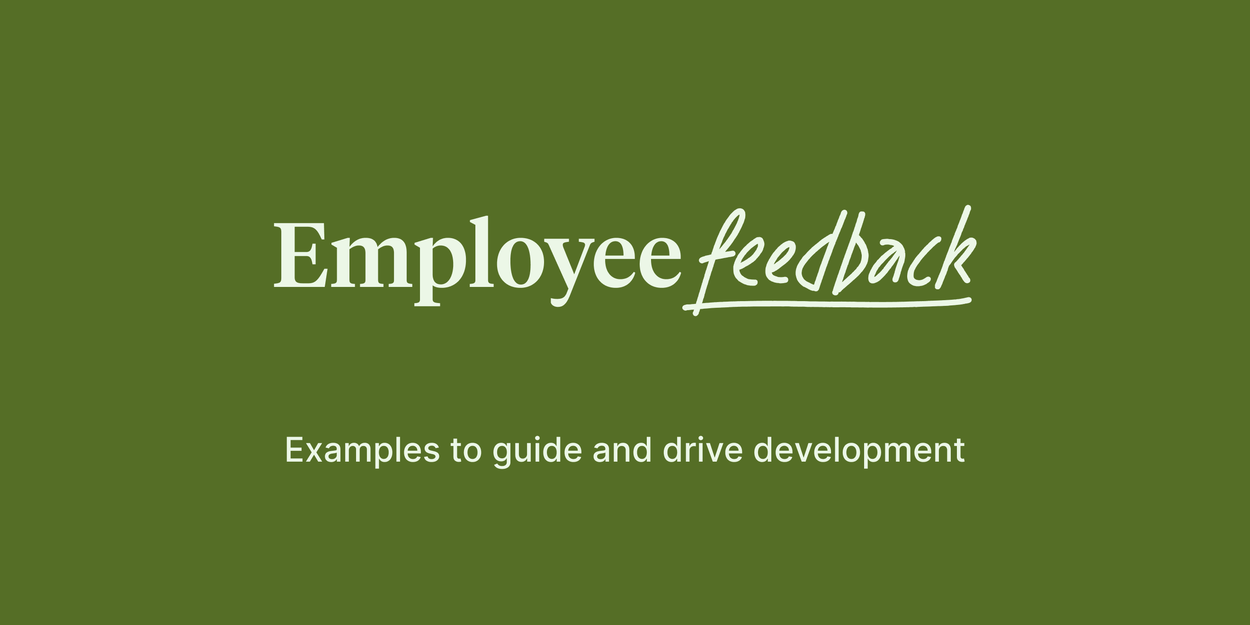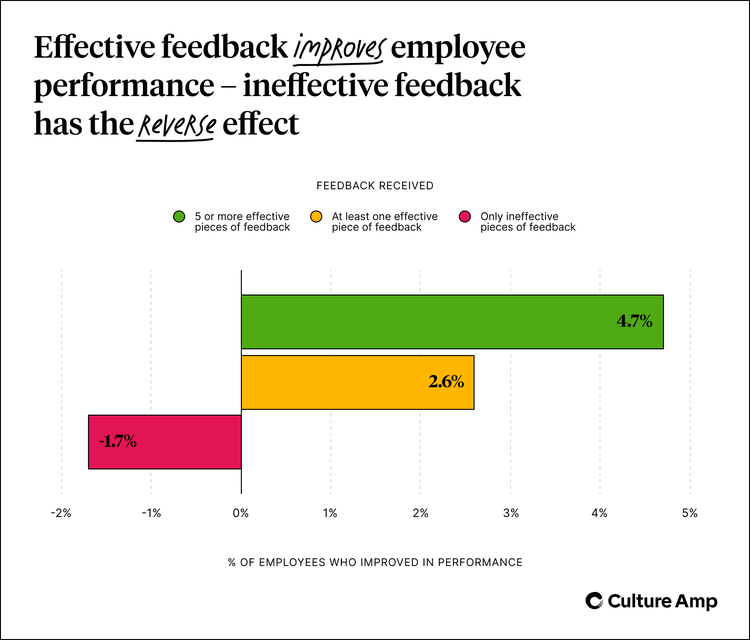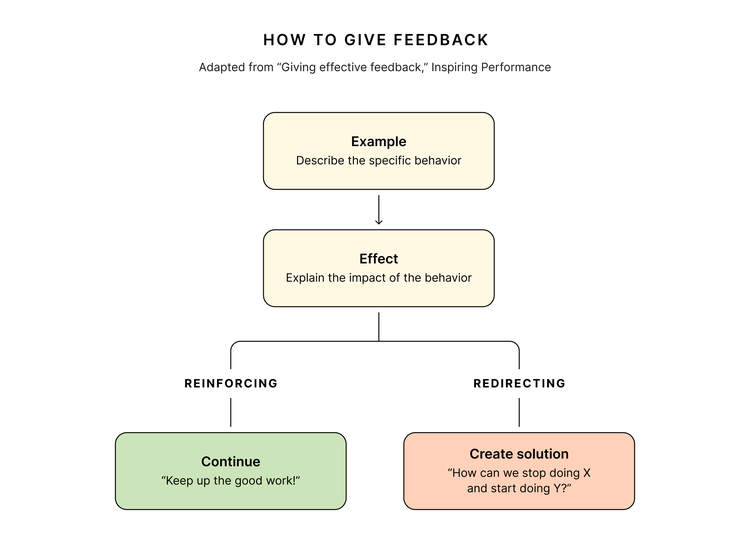
Article

Written by

Senior Content Marketing Manager, Culture Amp
When we think about receiving feedback at work, the first thing that comes to mind is often our last performance review – and the memory may not be a happy one. The typical annual performance review process doesn’t inspire self-confidence, nor does it typically drive employee development or growth.
Don't you think it's time we changed that?
Ongoing employee feedback is critical to moving away from outdated performance reviews and towards driving employee development. But creating a culture of continuous feedback that drives growth and development is only possible if employees feel empowered to give feedback in impromptu moments, not just during the formal performance review process.
Whether you're a manager or a fellow team member, giving feedback to others doesn’t have to be intimidating. In this blog, we'll share examples of constructive, actionable employee feedback that you can use to guide yourself and your team toward a culture of continuous feedback, including tips on asking for feedback, things to keep in mind when giving feedback, and more.
Employee feedback is any information given about a person’s actions or accomplishments at work, which they can then use to guide future improvement. It’s a crucial part of evolving traditional performance reviews into a process that fosters ongoing employee growth and development. To put it simply, feedback is important because it works.
Don’t just take our word for it, though – Culture Amp’s people scientists have found that receiving effective feedback actually improves an employee’s performance.

When comparing ratings from two consecutive performance reviews, we found that 5% more employees showed improvement in their performance when they received five effective pieces of feedback, compared to those who didn’t receive any feedback. Interestingly, employees who received ineffective feedback were also 2% less likely to improve than those who received no feedback at all.
People commonly divide employee feedback into two categories: "positive" and "negative." Positive feedback is usually associated with praise or congratulations, whereas negative feedback is generally associated with criticism.
While thinking in terms of positive and negative feedback is very common, Culture Amp’s people scientists suggest a more nuanced approach to feedback. Being more specific can help us give much more effective feedback that can really help employees grow and thrive.
Our people scientists break feedback into three categories:
For the purpose of this article, we will focus primarily on developmental feedback. Developmental feedback is important for growth as it is delivered with time for employees to act on it, e.g., strengthen skills or course-correct before a performance review.
There are two main types of developmental feedback:
Redirecting feedback is given when we want someone to stop doing X and start doing Y (e.g., speaking up more at meetings). This type of feedback describes observed behaviors that could be improved or adjusted, and should specify the impact of the behavior as well as actions for future improvement.

While many of us are familiar with the “feedback sandwich” in which negative feedback is “sandwiched” between positive feedback, Culture Amp doesn’t recommend this model.
Instead of following a formulaic approach to giving feedback, we highly recommend that you prioritize providing regular, balanced, and honest feedback that supports psychological safety.
Aim for offering a balance of reinforcing and redirecting feedback. While it may be most useful during performance reviews, we encourage you to give both types of feedback regularly throughout the performance cycle.
Try and avoid creating a “culture of niceness” in which only recognition or reinforcing feedback is delivered throughout the year. You don’t want redirecting feedback to come as a surprise during review time, and you want to ensure that folks have enough time to take action on their redirecting feedback before performance review season starts.
Reinforcing feedback can be given at any time. The more often you can provide this type of feedback to your direct reports or peers, the better.
Our people scientists explain:
“Feedback doesn’t have to be when you’re sitting down for a 1-on-1 meeting. It’s valuable to get feedback (especially when it’s positive) at any time. It’s like when you get a present on a day that’s not your birthday – it’s extra special because it’s unexpected.”
Use these examples of reinforcing feedback to guide you, adjusting the language to what feels natural.
Example: “I appreciate how you approached the project. Your problem-solving resulted in identifying three cost reductions, saving the team time and resources. This really helps others in the team."
Example: “You did a great job with the all-hands meeting. You structured the agenda to allow everyone to contribute, which improved team engagement and helped everyone to communicate effectively."
Example: "One of your most impactful moments was how you handled [project]. You showed the power of user testing in shaping a feature roadmap. Your efforts increased the likelihood that we satisfy and delight our users. I'd love to see you do more of this.”
Example: "I really admired the way you managed our remote team during the latest project. Your open communication helped everyone stay aligned and engaged, even with the distance. This has made a noticeable difference in team morale and productivity – please keep this approach up!"
Example: “I can see you're having a positive impact in your new office. Your team-building sessions have sparked stronger collaboration and lifted morale. I’ve seen this come through in our team’s feedback and engagement.”
Redirecting feedback is often more difficult to give than reinforcing feedback. However, it's vital – and even desired – that you provide it. According to a study documented by the Harvard Business Review, 92% of respondents agreed that “redirecting feedback, if delivered appropriately, is effective at improving performance.”
While reinforcing feedback can also be given at any time, it's good practice to ask before providing someone with redirecting feedback. By asking first, you confirm that the recipient is in the right mindset to receive what you’re about to say. Before giving feedback, try to get a sense of how the person is feeling and whether or not that person is aware of the topic on which you plan to give feedback.
Use the following examples to frame your redirecting feedback:
This is a great way to open and kick off the conversation. It signifies to someone that you are about to provide feedback and that you are thinking about how they’re feeling.
This is a good segue to use after a project or presentation. The person’s response will often clue you in on their thoughts. Then, you can expand on the areas of improvement you noticed.
This phrase is especially useful in a project-based environment, but you can use it anytime to start a feedback conversation. Give the person time to share their own feelings on the situation, especially if they led the project.
This phrase is handy when checking how your direct report (or peer) thinks things are going. It sets the stage for a feedback conversation they can lead rather than leaving them surprised by the feedback.
If you're a manager, you'll sometimes receive feedback about your direct report from others.
Sharing third-party feedback with your direct report can be tricky, because it should generally avoid hearsay and focus on an individual’s unique experience. Nonetheless, be prepared to discuss third-party feedback, as it may come up from time to time.
Effective third-party feedback offers:
We recommend using this phrase to start the conversation:
"Can I share with you a bit of feedback that I/we have been hearing?"
Example of third-party feedback:
"I've heard consistent feedback from several colleagues regarding how project updates are communicated. Would you be open to discussing their observations and exploring ways to improve clarity?"
While it may feel uncomfortable or awkward, giving feedback to your manager (upward feedback) is crucial to helping them improve as a leader. Managers benefit from insights that only their team can provide, and contributing this feedback supports a culture of continuous learning and shared improvement.
In fact, Culture Amp research shows that organizations where employees are encouraged to give upward feedback have more positive employee perceptions of their managers and leaders, and also possess higher levels of motivation compared to companies that don’t.
Because of the natural power dynamic involved, giving upward feedback can feel riskier than giving feedback to peers or direct reports. Managers are often the most influential factor in your workload, recognition, and career progression. That dynamic can make it feel harder to speak up, but remember that managers may not often receive direct feedback and may value your insights more than you think.
All that said, how you deliver upward feedback matters just as much as what you say. Here are some ways to approach it thoughtfully:
Lead with curiosity and empathy
To avoid making the conversation feel confrontational, we recommend framing your feedback with softer, open-ended phrases like:
This kind of language signals that your intent is to support, not challenge, your manager and invites a two-way conversation.
Be a partner, not just a critic
When possible, offer to collaborate. When you point out an area for improvement, you can also consider asking, “How can I support you?” or “Would it help if I shared my perspective and we worked together on potential solutions?” Showing that you’re invested in the outcome – not just pointing out flaws – helps build trust and demonstrates shared ownership of outcomes..
Use the right channels for sensitive topics
Some feedback is best delivered directly and privately, such as during a 1-on-1 meeting. But if the issue involves serious concerns (e.g., misconduct, ethical issues, or systemic patterns), it may be more appropriate to:
Not every situation is right for direct upward feedback. Use your judgment and prioritize psychological safety.
Want more ideas? Check out this article on giving feedback to your manager.
Giving feedback to peers, whether it’s someone on your immediate team or a cross-functional collaborator, may feel a bit intimidating. You’re often working closely together, and there’s an undeniable desire to avoid conflict or tension. Don’t let that hold you back, because offering thoughtful feedback is one of the best ways to build trust, improve team dynamics, and help each other grow.
Look for ways to offer peer feedback casually or conversationally. Here are a few principles to keep in mind:
Want more tips? Check out our guide to giving effective peer feedback.
The examples above are intended to help you give effective feedback to fellow team members or direct reports. It’s worth noting that giving someone feedback involves many factors besides the language you use to start the conversation.
With that in mind, here are six tips for giving effective feedback.
Put yourself in the shoes of the person about to receive feedback. Consider whether they are in the best mindset to listen to your feedback and whether you’re in the right mindset to share it. Strong emotions can cloud a person’s ability to accept feedback, whether it's positive or negative, reinforcing or redirecting. If emotions are running high, wait for a more neutral time to provide feedback.
Think about the person you're about to speak with before giving feedback. Consider the following:
Your feedback needs to give enough information for someone to either continue what they've been doing or change it. However, it's hard to properly deliver this information without prior thought and preparation.
For example, consider reviewing something like the SBI model (our recommended model for giving feedback) before your next feedback session.
Specificity is essential for learning, whether you give reinforcing or redirecting feedback. Without specificity, people may be confused about what exactly they should continue or stop doing. Telling someone they did a good job or are a great team player is a nice compliment, but that person won't know which behaviors you want them to repeat in the future.
When you communicate feedback, refer to observable behaviors, the context, and overall impact, enabling the receiver to understand which actions to repeat or adjust.
Research shows that receiving criticism for past behavior doesn’t motivate people to change. Instead, they simply shut down and become defensive. In contrast, receiving feedback that addresses how people can reach their goals or improve themselves is empowering and motivating.
That's why it's essential to give employee feedback on behaviors that the employee can do something about. Avoid personality judgments such as “You are lazy." Not only is this nonspecific, but it's also an unfair evaluation of who that person is rather than what they're doing. People grow and change, but altering core personality attributes is extremely difficult. Instead of calling someone "lazy," provide meaningful, actionable feedback such as:
Not every action or situation requires feedback, but it's important to make regular feedback a priority. When reinforcing feedback is given often, redirecting feedback becomes less of an ordeal. Regular feedback also shows people that you care about them personally.
If you work in a global company, it's important to consider cultural differences in giving and receiving feedback. For example, while straightforward language is often preferred in countries like the United States, other countries may prefer more indirect forms of communication.
In an organization with a strong and healthy feedback culture, people don't just give or receive feedback – they ask for it.
That's why one way to diffuse tension around giving and receiving feedback is to ask for it more often. The more you incorporate feedback into your routine, the less stress builds up around feedback conversations.
While we might be biased towards feedback at Culture Amp (one of our values is “Learn faster through feedback”), we honestly believe that feedback is the best way for people to grow and develop. In addition to asking for feedback from others, we strongly recommend adopting upward feedback – giving feedback to your manager and others above you.
Start soliciting feedback from your team by using the following questions:
Feedback is a two-way street. We can receive it, but it doesn't mean much if we don't apply it. Moreover, when we show others that we can incorporate feedback to drive our development, others may try harder to embrace feedback themselves.
Of course, learning from feedback is often easier said than done, particularly when we're receiving redirecting feedback. If you resonate with this, try this five-step process for learning from feedback.
Approach feedback with one goal in mind: listening. Listening to feedback is the first step to learning from it.
Our people scientists explain,
“Critical or redirecting feedback can put us in a defensive mode and restrict our ability to focus on solutions – we want to react. Knowing this, we can see why it is important to develop the habit of first just listening to feedback, rather than reacting.”
Everyone has room to learn and grow, but we can only do so if we know about those opportunities. When making sense of feedback, focus less on whether you did or did not do something specific. Instead, ask yourself, "What about my behavior could lead to this perception?"
For example, you might hear feedback such as “You need to be more assertive.”
Though this isn't the best example of effective feedback, you would ask yourself, "What could be influencing people to perceive me this way?" By listening to feedback with an open mind, you can better understand why you're receiving the feedback and if there are any actions or behaviors you may have unconsciously demonstrated.
If you don’t fully understand someone’s feedback, ask open-ended questions to keep the conversation going.
Consider the feedback example, “You need to be more assertive.”
If you receive feedback like this (i.e., vague or personality-based), seek clarification about observable behaviors and their impact. For example, “Could you provide examples of situations where this was evident and the impact it had?”
By asking follow-up questions, you can gain more insight into the behavior and understand what you’re expected to stop, start, or continue to do in the future. It also ensures you have the clarity you need to hone in on the crux of the feedback.
For example, you may interpret that feedback as being about speaking up more at meetings when it's really about amplifying your successes in front of leaders.
Take the time to absorb and process feedback. Focus on what specifically you will do to change or reinforce a certain behavior. Then, look for ways to apply the feedback to your day-to-day work. If you’re unsure how to act on it, check in with the person who provided the feedback to learn more about what they had in mind.
Giving feedback can be a challenging and scary thing to do. Few people enjoy confrontation, and even fewer people like to hurt others' feelings. That's why it's so important to express gratitude for feedback, even if it was hard to hear. Thanking the person for their feedback can strengthen feelings of psychological safety and trust between the two of you.
Moreover, you will be more likely to receive honest, valuable feedback in the future, which will help build a culture of ongoing feedback in your company.
So, what does creating a culture of feedback mean for the future of performance reviews?
As performance management continues to evolve, organizations are recognizing that ongoing, high-quality feedback throughout the year not only fuels individual development but also ensures that reviews offer an accurate and meaningful reflection of growth.
While annual performance reviews have historically provided a summary assessment of an employee’s performance, they haven’t always offered the regular, actionable insights employees need to make real progress. By integrating continuous feedback from leaders, managers, and peers, organizations help employees and teams consistently iterate, improve, and engage with their own development.
When feedback is delivered thoughtfully, performance reviews become a culmination of an ongoing journey, not just a point-in-time evaluation. This ultimately empowers people to achieve their full potential and contributes to building a thriving culture of ongoing feedback.
Ready to create a culture of feedback at scale? Culture Amp’s AI Coach delivers personalized insights and expert coaching that help managers become stronger, more impactful leaders – all via a conversational interface.
From business change to effective feedback, AI Coach is designed to help managers role-play high-stakes conversations and complex situations with skill and empathy.
